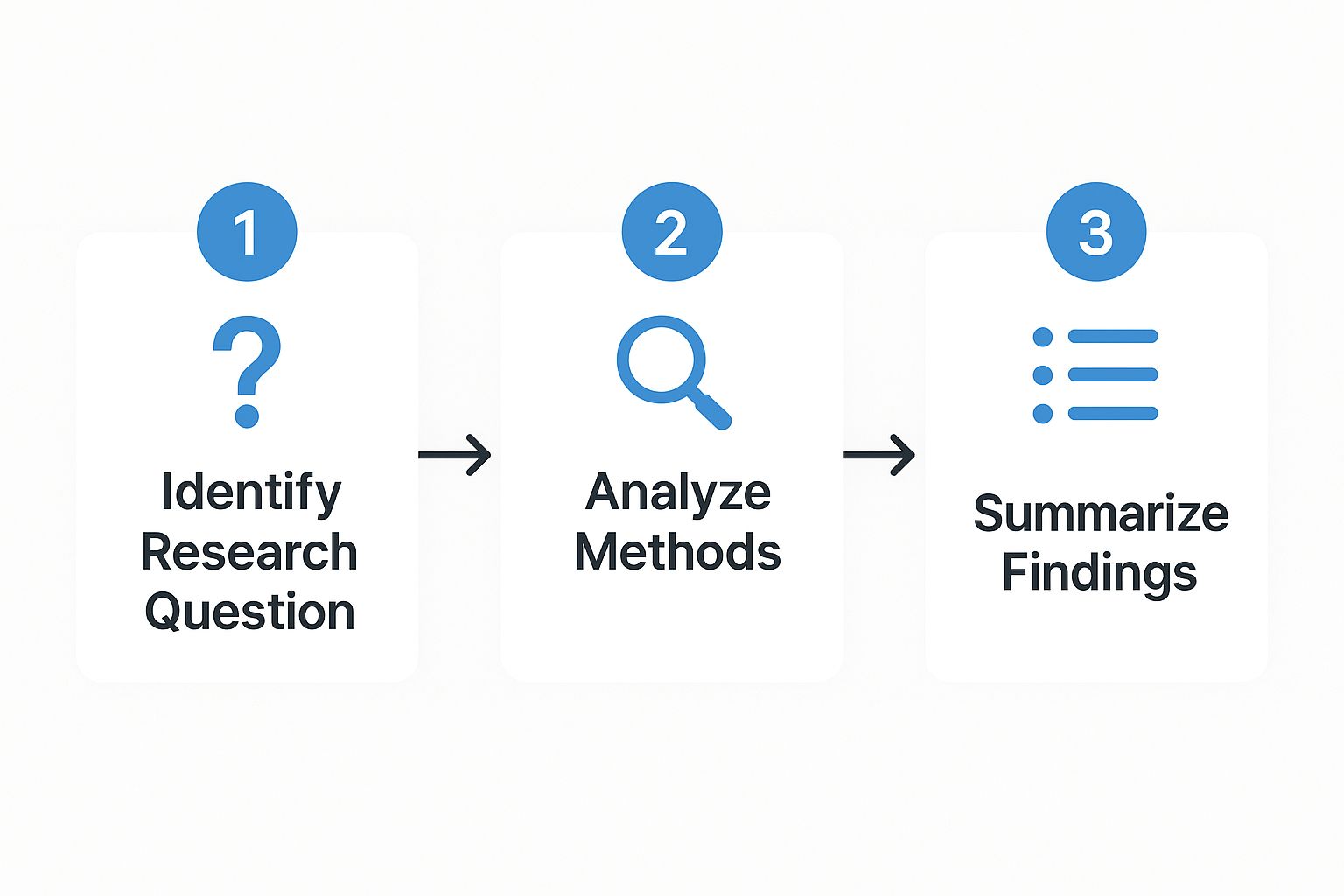Why Mastering Research Article Summaries Matters Now

The sheer volume of research available can be overwhelming. Staying current with the latest findings requires more than just passively reading; it demands the ability to quickly and accurately summarize research articles. This essential skill allows you to efficiently process key information, saving you valuable time and energy.
Imagine trying to follow advancements in fields like artificial intelligence without a method to distill complex research papers into their core components. The ability to summarize effectively becomes paramount for navigating this constant influx of information.
This information overload is a demonstrable trend. Global research output has significantly increased. In 2018, there were 2.6 million peer-reviewed science and engineering publications, a substantial jump from 1.8 million in 2008. This represents a 4% annual growth rate worldwide.
China, notably, is a major contributor to this increase, publishing at nearly double the global average. By 2020, China was responsible for 23% of global science and engineering publications, surpassing the United States at 16%. You can explore this growth in more detail here. This rapid expansion underscores the importance of efficient summarization techniques.
The Benefits of Efficient Summarization
Mastering research article summaries offers several advantages. First, it drastically improves comprehension. By condensing a complex study into its core arguments and findings, you develop a more robust understanding of its contributions.
Additionally, concise summaries improve knowledge retention. Distilling the essential information makes it easier to remember and apply key takeaways later. This makes summarizing a vital skill for researchers at every level.
It's no longer sufficient to simply read; researchers must synthesize and apply the information effectively. This ability to synthesize is particularly crucial when connecting ideas across different research areas and forming a holistic understanding of a given field. Ultimately, strong summarization skills empower researchers to navigate the ever-growing body of academic literature and put that knowledge into practice.
The Anatomy of a Powerful Research Article Summary

A strong research article summary doesn't simply rehash the information; it distills the core message of the research. This involves pinpointing the central arguments and presenting them with clarity and conciseness. What distinguishes a truly effective summary from a subpar one? Let's explore the key elements.
Key Components of a Summary
A powerful summary zeroes in on specific components of the original article. These components act as a roadmap, guiding the reader to a quick and efficient understanding of the research.
-
Research Question: Clearly articulate the question the research seeks to answer. This establishes the foundation for understanding the study's purpose and scope.
-
Methodology: Briefly outline the methods employed in the research. This encompasses the study type, the sample size (if relevant), and the data collection techniques. Concentrate on the general approach, avoiding granular details.
-
Key Findings: Showcase the most significant results of the study. This is where the central discoveries that address the research question are presented. Underscore statistically significant results and any practical implications.
-
Conclusions: Synthesize the authors' interpretations of the findings. What are the primary takeaways? How do these findings contribute to the existing body of knowledge?
To provide a structured approach to summarizing research articles, let's explore the essential components in more detail:
| Article Section | What to Include in Summary | Common Pitfalls to Avoid |
|---|---|---|
| Introduction | Briefly state the research problem and its significance. Include the research question(s) or objective(s). | Spending too much time on background information. Avoid reiterating common knowledge. |
| Methodology | Briefly describe the research design, participants, and methods used to collect and analyze data. | Getting bogged down in technical details or jargon. Focus on the overall approach. |
| Results | Summarize the main findings, emphasizing statistically significant results and practical implications. | Misinterpreting findings or overstating the importance of the results. |
| Discussion/Conclusion | Summarize the authors' interpretation of the findings and their implications for future research or practice. | Including your own opinions or interpretations. Focus on what the authors conclude. |
This table provides a practical framework for effectively summarizing the key sections of a research article. By understanding what information to prioritize and what pitfalls to avoid, readers can create concise and accurate summaries that capture the essence of the original work.
Building a Structured Summary
Creating a well-structured summary involves a systematic approach. Consider these steps:
-
Start with the Abstract: The abstract typically offers a condensed overview of the research. Use it as a springboard for understanding the main points.
-
Identify the Core Argument: What is the central message the authors aim to communicate? This should form the backbone of your summary.
-
Focus on the Results: While the methodology is important, the results are the driving force of the research narrative. Give them precedence in your summary.
-
Maintain Objectivity: Your summary should faithfully reflect the authors' findings, even if you disagree with their conclusions. Refrain from inserting personal opinions or interpretations.
Avoiding Common Pitfalls
Effective summarization requires vigilance against certain common traps:
-
Excessive Detail: Avoid getting lost in intricate details or specialized terminology. Concentrate on conveying the overarching message.
-
Misrepresenting Findings: Ensure accuracy in reflecting the original research. Double-check your understanding of the data.
-
Plagiarism: While paraphrasing is crucial, never directly copy sentences or phrases. Articulate the ideas using your own words.
-
Lack of Context: Provide sufficient background information to grasp the research's significance, but avoid excessive detail.
By adhering to these principles, you can craft powerful research article summaries that capture the essence of the original work while maintaining conciseness and accessibility. Tools like SmartStudi offer features like a large text summarizer and grammar checker to further polish your summaries, ensuring clarity and precision. Honing your skills with tools like these, especially learning how to craft effective AI prompts, can greatly simplify the summarization process. This ability to synthesize information efficiently is a critical asset in academic and professional environments.
From Complex Paper to Clear Summary: Your Roadmap

This infographic illustrates the three core steps for summarizing a research article: identifying the research question, analyzing the methods, and summarizing the key findings. Each step builds on the last, creating a straightforward path to a concise summary. By following these steps, researchers can effectively distill complex research papers into manageable components.
Summarizing research can seem overwhelming, but a structured approach makes it easier. This section offers practical techniques for condensing even the most complex studies into digestible summaries, applicable across various fields.
Pre-Reading Strategies for Efficient Summarizing
Start by previewing the article. Skim the abstract, introduction, and conclusion to understand the central theme and research direction. This provides valuable context for focused reading. Next, review the headings and subheadings to grasp the structure and information flow.
Then, identify the research question. What problem are the authors trying to address, or what gap in knowledge are they filling? Understanding this frames your subsequent reading and analysis.
Annotation Methods: Capturing Essential Information
After pre-reading, actively read and annotate the article. Highlight key terms, definitions, and significant findings. Summarize paragraphs or sections in the margins to encourage deeper engagement. For example, note connections to other research or emerging questions.
Consider a color-coding system. Use different colors for different information types, such as the research question, methodology, and results. This simplifies later review and the summarization process.
Organizing Information Hierarchically
After annotating, organize the information hierarchically. Begin with the central argument or research question at the top. Then, categorize supporting details like methodology, results, and conclusions underneath. This structure reflects the research paper's framework.
This hierarchical method is how many successful researchers organize their work. Interestingly, international research collaborations are growing. In 2020, nearly one in four articles had co-authors from different countries, up from one in seven in 2000. This highlights the importance of effective communication and summarization across cultures and disciplines. Learn more about international research collaborations.
Managing Statistical Data and Complex Methodologies
When working with statistical data, focus on overall trends and significant findings, not every data point. For example, instead of listing all p-values, emphasize statistically significant results and their implications. Similarly, simplify complex methodologies to their core components.
Concentrate on the overall research design and techniques used, avoiding jargon and excessive detail. This makes the summary accessible to a broader audience while preserving the research's core message. These techniques will help you summarize a research article accurately and concisely.
Research Summary Power Tools and Techniques

Moving beyond traditional note-taking opens a world of advanced methods for summarizing research articles. These techniques can significantly improve how you process information, particularly when dealing with a large volume of research. This section explores both digital tools and cognitive strategies employed by research professionals who routinely handle numerous papers monthly.
Concept Mapping: Connecting the Dots
Concept mapping is a powerful technique for visualizing and connecting ideas within a research article. It helps you see the bigger picture by illustrating the relationships between different concepts. This visual representation aids in understanding complex topics and identifying key themes.
For example, you can create a concept map to link the research question, methodology, findings, and conclusions. This provides a comprehensive overview of the study at a glance.
AI-Assisted Tools: Separating Hype from Help
Numerous AI-powered tools claim to simplify research summarization. However, some create more work than they save. It's crucial to identify tools that genuinely add value. Features like keyword extraction and automated summaries can be beneficial if they are accurate and relevant.
You might be interested in: How to master summarizing large texts with AI. Some AI tools excel at condensing lengthy articles into concise summaries, saving you valuable reading time. Others help with grammar and clarity, ensuring your summaries are well-written and easy to understand.
However, always critically evaluate the output of any AI tool, ensuring it aligns with the original research. Don't rely solely on AI; your own understanding of the material is paramount.
Annotation Systems for Faster Processing
Effective annotation systems can drastically reduce the time spent processing research articles. This is especially true for dense, complex papers. Methods like highlighting key terms, making marginal notes, and summarizing sections within the text help maintain focus and facilitate easier retrieval of information later.
The following table compares different tools and techniques for summarizing research, outlining their strengths and weaknesses:
Comparison of Research Article Summarization Tools
| Tool/Technique | Best For | Key Features | Limitations | Cost |
|---|---|---|---|---|
| Concept Mapping | Visual Learners, Complex Topics | Connects ideas visually, clarifies relationships | Requires practice, can be time-consuming initially | Free (using pen and paper) or cost of software |
| AI Summarizers | Quick Overviews, Large Volumes of Text | Fast summaries, keyword extraction | Accuracy varies, may require editing | Varies, some are free, others require subscriptions |
| Annotation Software | Detailed Analysis, In-Depth Understanding | Highlighting, note-taking, organization | Learning curve for some software | Varies, some are free, others require subscriptions |
| Manual Summarization (Notes) | Focused Reading, Conceptual Understanding | Personalized, flexible | Time-consuming, requires strong analytical skills | Free (using pen and paper) |
This table summarizes various approaches to research summarization, considering their ideal use cases, core functionalities, and potential drawbacks. Cost is also a factor, ranging from free methods like manual note-taking to subscription-based AI tools and software.
Choosing the Right Tool for the Job
The right combination of tools and techniques depends on your individual learning style, research needs, and workflow. Experiment with different approaches to find what works best for you. Developing a personalized system that scales with your growing expertise is the key to managing information effectively and maximizing your research efficiency.
For instance, while AI tools can provide quick summaries, they are most powerful when combined with critical analysis and traditional methods like concept mapping and annotation. This ensures that you understand the nuance and context of the research.
Overcoming the Research Summary Roadblocks
Summarizing complex research articles can be challenging, even for experienced researchers. From deciphering dense statistical analyses to navigating conflicting findings, creating effective summaries requires a specialized skillset. This section addresses these common difficulties, offering practical solutions for tackling even the most demanding research literature.
Managing Information Overload
One of the biggest obstacles in summarizing research is the sheer volume of information. It can feel overwhelming, like trying to drink from a firehose. A helpful strategy is to break the process down into smaller, more manageable parts. Start by identifying the central argument and then concentrate on the supporting evidence.
Before diving into the details, preview the abstract, introduction, and conclusion. This provides a roadmap of the research, highlighting key information to look for as you read. This pre-reading step helps distinguish essential information from less critical details.
Handling Poorly Structured Papers
Research articles aren’t always well-organized. Some have confusing layouts or lack clear transitions, making summarization more difficult. In these cases, consider creating your own structure. Identify the main points and arrange them logically. This might involve outlining the information hierarchically or using a visual tool like a mind map. AI tools can also be useful for summarizing complex research, particularly if you understand effective prompting. For more information, check out this article on writing AI prompts.
Clear and concise writing is crucial for conveying complex information effectively. You might find this resource on how to master grammar helpful for ensuring clarity and precision in your summaries. A poorly written summary, even if accurate, can diminish the impact of the original research. Avoid jargon whenever possible.
Maintaining Objectivity
It’s tempting to let personal biases influence your summary, especially when you disagree with the findings. However, objectivity is crucial. Your summary should accurately reflect the authors' arguments and conclusions, regardless of your personal opinion.
For example, the United Nations High Commissioner for Refugees (UNHCR) tracks global displacement trends. At the end of 2023, 117.3 million people were forcibly displaced worldwide. This data provides valuable context for research related to migration, irrespective of your personal views. This highlights the importance of using data for context and maintaining objectivity, even with sensitive topics. More detailed statistics can be found here.
Translating Technical Jargon
Many research articles are filled with technical jargon. While essential within the field, this specialized language can make research inaccessible to a wider audience. When summarizing, try translating jargon into plain language.
Be careful not to oversimplify or misrepresent the research. The goal is to make the information understandable without sacrificing accuracy. This skill is crucial for effective communication, especially when sharing research across different disciplines. By addressing these challenges directly, you can confidently summarize even the most complex research and create compelling, informative summaries.
Custom Approaches for Different Research Formats
Different research articles require different summarization approaches. A one-size-fits-all method simply won't capture the nuances of various research types. This section explores specialized techniques for summarizing diverse research formats, from quantitative studies packed with data to qualitative analyses rich with interpretive detail.
Quantitative Research: Data-Driven Summaries
Quantitative research emphasizes numerical data and statistical analysis. When summarizing these articles, focus on the key variables, the relationships between them, and the statistical significance of the findings. For example, highlight the effect size and confidence intervals rather than getting bogged down in the raw data. This approach ensures your summary remains concise and focused on the most impactful results. Additionally, clearly state the research question and the methods used to collect and analyze the data.
Qualitative Research: Capturing Nuance and Context
Qualitative research explores complex social phenomena through in-depth interviews, observations, and textual analysis. Summarizing these articles involves capturing the main themes, perspectives, and interpretations presented. Focus on the researchers' analysis of the data, including any recurring patterns or significant contradictions. Unlike quantitative summaries, qualitative summaries often require more detailed descriptions to convey the richness of the findings.
Meta-Analyses: Synthesizing Multiple Studies
Meta-analyses combine the results of multiple studies to draw broader conclusions. When summarizing a meta-analysis, focus on the overall effect size across the included studies, any variations in effect size, and the factors contributing to these variations. Clearly state the criteria used to select the studies and any limitations of the analysis. This approach gives readers a clear understanding of the combined evidence and its implications.
Theoretical Frameworks: Distilling Core Concepts
Theoretical articles present new or refined conceptual frameworks for understanding a particular phenomenon. Summarizing these articles involves distilling the core concepts, principles, and propositions of the framework. Focus on the key arguments and how the framework differs from existing perspectives. Provide clear definitions of key terms and illustrate the framework with relevant examples. Proper citation is essential when summarizing theoretical articles to acknowledge intellectual contributions and avoid plagiarism. You might be interested in: How to master citations with our citation generator.
Discipline-Specific Considerations
Each academic discipline has its own conventions and expectations for research summaries. For instance, medical research summaries often prioritize clinical implications, while social science summaries might emphasize theoretical contributions. Therefore, tailor your summarization approach to the specific field of study. Consider the intended audience of your summary and adjust your language and level of detail accordingly. Learn more in our article about how SmartStudi can help you with summaries.
By adapting your summarization techniques to the specific format and discipline of the research article, you can create concise, accurate, and insightful summaries that effectively capture the essence of the original work. This versatile skill becomes increasingly valuable as you navigate the diverse landscape of academic literature. Ready to take your research summarization skills to the next level? Explore the power of SmartStudi, an all-in-one platform designed to help students excel in their academic pursuits. From AI-powered text summarization to grammar checking and citation generation, SmartStudi provides the tools you need to efficiently process and synthesize information. Visit SmartStudi today and discover how it can transform your research workflow.
